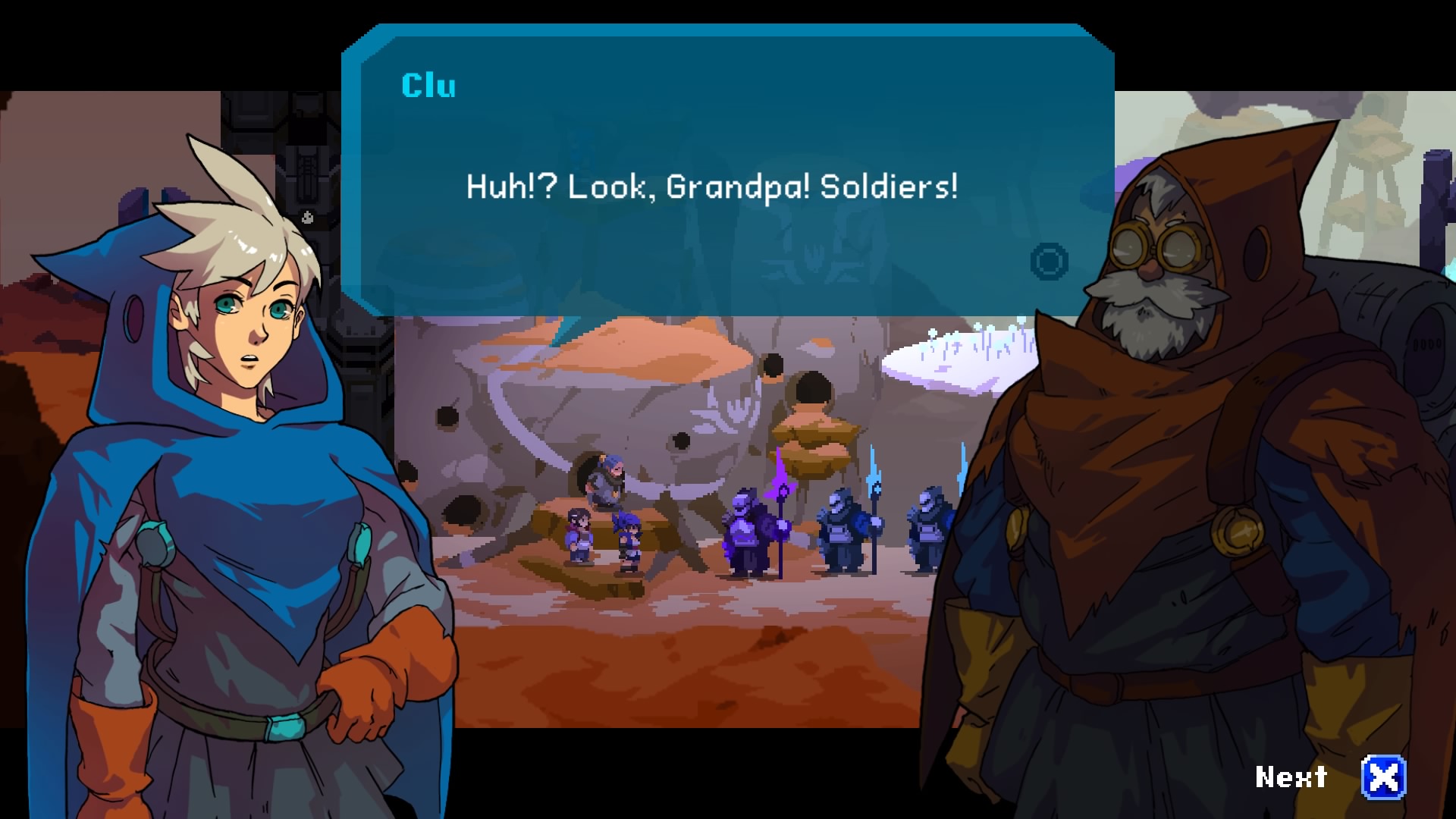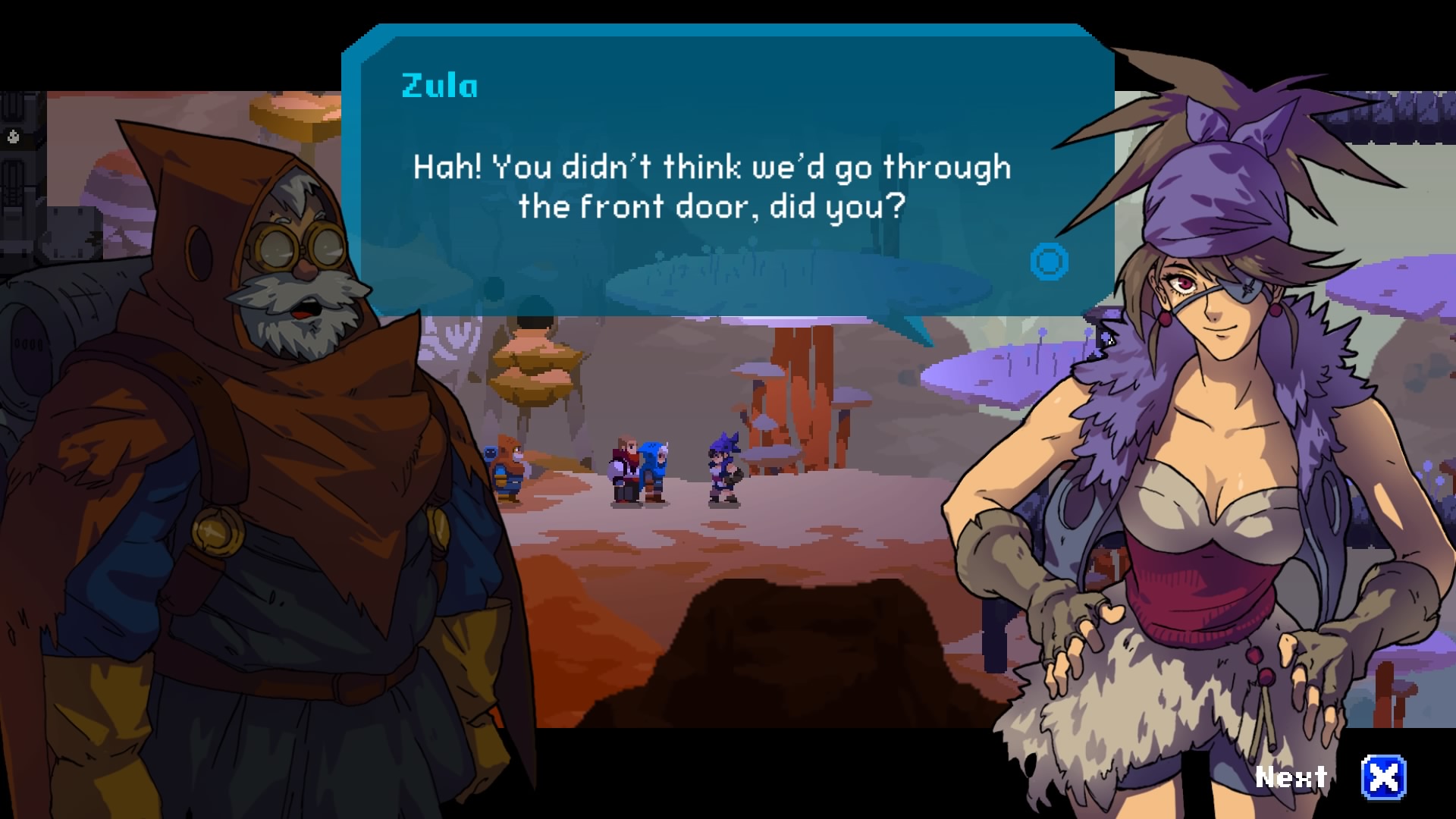Our Verdict
With a local co-op buddy Aegis Defenders becomes a fun mix of genres, but when playing solo it can be an exercise in frustration.
PC Gamer's got your back
What is it? Pixelated, 2D platforming tower defense for two.
Expect to pay $20/£15
Developer GUTS Department
Publisher Humble Bundle
Reviewed on GTX 1080, Intel i5-6600K, 16GB RAM
Multiplayer 2 player local (split-screen)
Reviewed on Windows 10, AMD FX-8350, 8GB RAM, GeForce GTX 960
Link Official site
Things were going well until the escort mission. My regular tactic of hiding behind towers and traps didn't work when I had to safeguard a caravan across a level full of monsters, trying to keep things moving while also juggling multiple characters and opening pathways for them. After several failures I recruited a co-op partner, and the challenge suddenly went from frustrating to exciting. Aegis Defenders can be an enjoyable cooperative mix of tower defense and platforming, but playing solo did test my patience.
In Aegis Defenders you'll be exploring a level, jumping over pits, fighting monsters, switching between two characters to solve puzzles where someone has to stand on a platform to open a door for someone else—and then suddenly the genre changes. Now you have to defend yourself from waves of monsters by using your resources to construct defenses, the previously innocuous creatures suddenly turned dangerous by sheer numbers.

Aging engineer Bart and his granddaughter Clu are Ruinhunters, scavengers in a world of gods called Deathless. This is explained in a series of illustrated cutscenes between chapters that feel a bit heavy-handed and disconnected from the fast-paced action of the rest of the game. There are also dialogue scenes, in which I was graded on my responses by earning Ruinhunter Points (which unlock new and improved towers) for saying things people wanted to hear. It felt like there was always a right answer to every situation, rather than being free to actually roleplay.
But while most of the story does fall a bit flat (at least until a twist later in the story ups the excitement), the characters are legitimately funny and heart-warming, especially the cute little robot they reactivate named Kobo.

When playing solo I control both Clu and Bart, with the non-active character following invisibly. Clu has a rifle and is stronger against blue enemies, while Bart's hammer is effective against yellow foes. Puzzles take advantage of the multiple characters, which I switch between them with the press of a button, reminding me of The Lost Vikings. There are color-coded doorways that only allow one character to pass, forcing me to split up to hit switches, move blocks, and traverse spikes.
The puzzles work well but I was less enthused by fighting enemies. Character controls are a bit too floaty and awkward to make combat ever feel satisfying (you can’t shoot downward, for example). Enemies were mostly an annoyance that got in the way of my puzzle-solving.
Eventually you unlock two more allies. Kaiim the red monk was far more powerful and interesting than the starting pair, able to hurl fireballs and magnetically grab nearby resource nodes. Zula was stronger still, dashing across spikes and flinging a satisfying shuriken through multiple enemies. I rarely played as Clu or Bart in the later stages.

Switching between four characters can be unwieldy in the platforming sections, and downright frustrating during the tower defense climaxes of each level. Most levels end with a familiar set-up: a central thing you must defend against waves of enemies that spawn from the sides.
When playing with my co-op partner, most of these frustrations melted away. Suddenly we were having a blast.
Each character has a single defensive structure they can build. That tower can either upgrade or turn into something else completely if you build another tower on top of it. Clu's one-use bomb becomes a length of spike traps, while Zula's slowing field becomes a ghostly robot that shoots enemies. Combining two different characters' buildings creates even more variety: Clu's bomb and Bart's wall equals a triple-shot cannon, while Zula can turn anyone's building into a resource generator. It's a clever system that provides plenty of tower variety without complicated menus or button combinations.
Unfortunately I rarely have enough time to set everything up. Between waves there are only 60 seconds to collect resource nodes, check where enemies are coming from, build and upgrade towers, and put everyone in the right positions. It's overwhelming for a single player in the later levels, when sticking the right person and towers against the correctly colored enemies is critical. It also rewards foresight, meaning I had to replay many defense sections until I knew what I was facing, and when.

When playing with my co-op partner, most of these frustrations melted away. Suddenly we were having a blast. One person could quickly grab the scattered resources while the other built towers. We had fun shouting out where we needed a particular character during a wave—blue enemies, I need Clu over here! Even the horrendously difficult escort missions, which are thankfully few and far between, became manageable. Those missions were rage-inducing when playing solo, and I’m a veteran of many an action tower defense game, from Orcs Must Die! to Dungeon Defenders and Sanctum.
I can appreciate a game built specifically for local co-op, but it's frustrating when the balance doesn’t translate well when playing solo. Little changes, like eliminating the time limit between enemy waves or offering a single damn checkpoint on those escort missions, would have worked wonders.
With a local co-op buddy Aegis Defenders becomes a fun mix of genres, but when playing solo it can be an exercise in frustration.


